MMC4
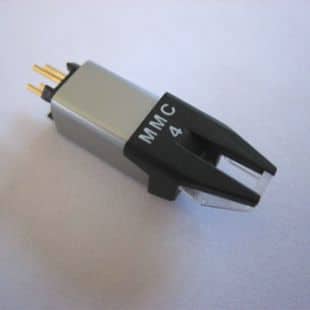
This could be regarded as the standard cartridge in the range and was fitted to many decks as standard.
In many ways a replacement for the MMC20E, it offered good performance at a most reasonable price

This could be regarded as the standard cartridge in the range and was fitted to many decks as standard.
In many ways a replacement for the MMC20E, it offered good performance at a most reasonable price
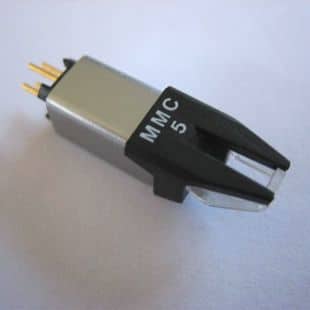
The most basic of the range, this cartridge was available to be specified for those decks not fitted with a cartridge as standard such as the Beogram RX.
It could be differentiated by its cantilever which was a straight non tapered aluminium tube.
If you want superior sound, but not the size, and a full array of functions but without the complication – then take a look at the BeoSound Century. Designed by David Lewis, it has a very slim depth and brings together CD, tape and FM radio into a slim-line form that can stand by itself or hang from a wall. Everything is operated by buttons that light up to guide you quickly through the various playing options.
BeoSound Century is a clever combination of excellent performance and ease-of-use. This system is known in fact by two different names – BeoSound Century in Europe and BeoSound 2000 in North America. With everything built in, this is the perfect stereo for those who with a limited space as it’s only 11cm deep. It’s for those who don’t want Beolink® capabilities and can be equipped with a handle with a built-in active antenna making it very portable. The speakers use the active construction as that of all BeoLab speakers. In the late nineties the Century was released in a special limited series with polished aluminium instead of the black plastic on the CD holder. This became so popular that it became the standard! There are two different stands available: a wall stand and a special table stand. The unit may also be controlled by the optional Beo4 remote control.
Deep bass
BeoSound Century integrates a powerful sound reproduction system: two active loudspeakers with electronic crossover network and Adaptive Bass Linearisation, for the optimum relationship between bass reproduction and sound pressure level. The very small two-way bass reflex loudspeakers comprise a net volume of only 1,1 litres, but the large front grille gives room for fairly large woofer membrane diameters.
Bass and treble have separate power amplifiers, which means that they can be tailored to compensate for one another’s shortcomings and deliver a sound spectrum as close to reality as possible. On top of that, BeoSound Century can play at high volume, but cuts out before it has an opportunity to burn out its units.
The fine art of control of BeoSound Century
The backlit push buttons of the BeoSound Century are cast in opalescent plastic, painted black on the inside and the text is then burnt away with a laser. The light of a diode behind each button is muted for even distribution, and the button is hinged in four places. A sturdy and relatively inexpensive construction, but it takes just a bit more work!
Operation of BeoSound Century
How do you make operation easy when there are 26 buttons to push? On BeoSound Century, only the buttons you need for the specific function will light up and guide you step by step through operations.
BeoSound Century was awarded the Danish Design Centre’s IP Prize in 1994.
Mounting Options
Supplied with a table mount foot for mounting on top of a cabinet. The optional wall mount bracket allowed for wall mounting.
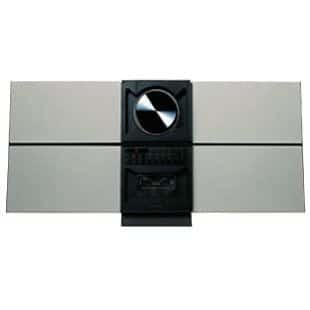
If you want superior sound, but not the size, and a full array of functions but without the complication – then take a look at the BeoSound Century. Designed by David Lewis, it has a very slim depth and brings together CD, tape and FM radio into a slim-line form that can stand by itself or hang from a wall. Everything is operated by buttons that light up to guide you quickly through the various playing options.
BeoSound Century is a clever combination of excellent performance and ease-of-use. This system is known in fact by two different names – BeoSound Century in Europe and BeoSound 2000 in North America. With everything built in, this is the perfect stereo for those who with a limited space as it’s only 11cm deep. It’s for those who don’t want Beolink® capabilities and can be equipped with a handle with a built-in active antenna making it very portable. The speakers use the active construction as that of all BeoLab speakers. In the late nineties the Century was released in a special limited series with polished aluminium instead of the black plastic on the CD holder. This became so popular that it became the standard! There are two different stands available: a wall stand and a special table stand. The unit may also be controlled by the optional Beo4 remote control.
Deep bass
BeoSound Century integrates a powerful sound reproduction system: two active loudspeakers with electronic crossover network and Adaptive Bass Linearisation, for the optimum relationship between bass reproduction and sound pressure level. The very small two-way bass reflex loudspeakers comprise a net volume of only 1,1 litres, but the large front grille gives room for fairly large woofer membrane diameters.
Bass and treble have separate power amplifiers, which means that they can be tailored to compensate for one another’s shortcomings and deliver a sound spectrum as close to reality as possible. On top of that, BeoSound Century can play at high volume, but cuts out before it has an opportunity to burn out its units.
The fine art of control of BeoSound Century
The backlit push buttons of the BeoSound Century are cast in opalescent plastic, painted black on the inside and the text is then burnt away with a laser. The light of a diode behind each button is muted for even distribution, and the button is hinged in four places. A sturdy and relatively inexpensive construction, but it takes just a bit more work!
Operation of BeoSound Century
How do you make operation easy when there are 26 buttons to push? On BeoSound Century, only the buttons you need for the specific function will light up and guide you step by step through operations.
BeoSound Century was awarded the Danish Design Centre’s IP Prize in 1994.
Mounting Options
Supplied with a table mount foot for mounting on top of a cabinet. The optional wall mount bracket allowed for wall mounting.
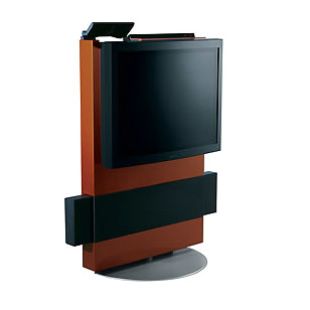
” Picture this. The perfect picture “
BeoCenter AV5 was, at first glance, merely a television set. However, what you saw was just half the picture. The AV5 was in fact a fully integrated, compact digital home entertainment system, comprising a CD player, FM radio and powerful loudspeakers… as well as a television!
On top of the AV5 a CD player elegantly lifted open to allow you to drop in your CD and listen.
BeoCenter AV5 therefore offered the best of both worlds and allowed you decide. At the touch of a button, two motor-drive loudspeakers stretched silently out to each side of the TV set. It was a simple, welcoming gesture but one that also ensures a special performance every time you switch on. The extra width allowed the loudspeakers to combine with the ear-shattering centre bass to produce optimal stereo sound in its full perspective. It was something you could hear – and feel – every time you watched a movie or listened to the in-built radio or played a CD. Indeed, BeoCenter AV5 was so versatile that at the time of its introduction, it could also play CD-i discs.
Devoting efforts in creating the perfect sound didn’t mean that Bang & Olufsen had forgotten what they knew about creating the perfect picture. On the contrary. The AV5’s 63cm super flat picture tube, combined with the contrast screen’s anti-reflective coating, delivered a sharper picture, with more depth and perspective, than you had ever seen before. So when the AV5’s electronic curtains glided open you could be sure that what lay behind them was pure entertainment.
Another original Bang & Olufsen feature added to daylight viewing comfort. It was a small electronic sensor that registered the prevailing light conditions in the room and adjusted the picture, so that it was always sharp, no matter whether a reading lamp was lit or sunlight suddenly poured through the window.
Touch CD on the Beo4 remote control and the AV5 moved on its motorised stand to face the viewer’s favourite viewing position. And active speaker stretched out from each side. On top, a CD player elegantly lifted open to allow you to drop in your CD and listen. The superior sound of the AV5 was made possible by the creation of a ‘soundscape’ that widened the perspective of the sound to make each individual instrument clear and distinct. Combined with an inbuilt, ear-shattering centre bass, the AV5 delivered a sound so rich and true that the effect was remarkably similar to a dedicated surround system.
Like every other Bang & Olufsen product, Beovision AV5 was designed and crafted with the greatest care. To ensure that the powerful centre bass unit didn’t interfere with the steadiness of the picture, it was mounted on an intricate suspension system, which in turn was anchored to a special aluminium chassis. The CD unit was perhaps the most robust then, on the market, to allow it to cope with the demanding environment – electronic noise, hot air and interference – in which it had to perform. And on top of all that, the entire unit was ‘torture tested’ hundreds of thousands of times to make sure that it could cope with the rigours of daily use!
The rear of the AV5 is removed by undoing four screws. It may have taken some 150 tools and six construction engineers to make the parts and components, but as far as possible, one size of screw was used to assemble the AV5. The result was, up to 1999, the most advanced piece of electronic design ever to leave the Struer assembly line. Yet everything follows a strictly modular pattern, making maintenance and servicing logical and straightforward.
How can 15 centimetres make a world of difference if you’re already sitting in front of the television, ideally positioned between the stereo loudspeakers?
If you want the full perspective of, say a symphony and you want to be able to identify each instrument in the orchestra, a distance of 80 centimetres is the absolute minimum. You must also make sure that the loudspeakers deliver exactly the same performance and have the same harmonic balance. This can only be obtained by the painstaking measurement, trimming, and pairing of every single tweeter and baffle that goes into the AV5 (or into any other Bang & Olufsen loudspeaker for that matter). Some manufacturers obtain “spatial effect” by reversing the signal phase on one side. This creates a broader perspective, but makes it impossible to locate voices or single instruments.
The picture tube was a new 25″ ‘super-flat state-of-the-art’ tube. It delivered excellent focus, which, combined with the anti-reflective coating of the contrast screen, was experienced as a sharper picture with more depth and better resolution.
The fact the loudspeakers disappeared into the front wall, calls for a special bearing structure. In the AV5, the heaviest component was the picture tube, which was fixed to a set of aluminium “antlers”, a moulded aluminium space-frame which also carried the loudspeakers and most of the wiring. Cast in two pieces, it was custom-designed to hold wiring and fixtures that traditionally, would have been mounted with additional clamps and screws. Aluminium has the advantage of being light, but rigid and non-vibrating. It will not conduct sound or allow oscillations that could affect sound or picture reproduction.
‘Dance steady’ is a term that B&O takes dead seriously. It refers to a product’s ability to perform effortlessly, no matter how animated the surroundings. The company’s secret remedy is rubber suspension. Inside the AV5, almost every vital unit was isolated from the bearing structure by little rubber sleeves. The transformer, the CD print card, the CD drive and last but not least, the centre bass, since it was the source of a sizeable proportion of the vibration pattern. Dance steadiness is measured on a vibrating table to determine the design of each individual rubber sleeve.
Imagine that you’d turn the AV5 on and off maybe 10 times a day over the next ten years and multiply that by 5 for safety. That’s equivalent to turning it on and off 180,000 times over 10 years. In B&O’s torture chambers in the dungeons in Struer, the loudspeakers on the guinea pig AV5 were stretched well beyond the first 500,000 times!
Buffers, shielded cables and a couple of brave hearts went into one of the most challenging technical solutions in the AV5. To make room for the CD player in the upper corner, it was necessary to separate the drive from the control unit. In an environment as compact and loaded with “electronic noise” as the AV5, a lot of sources could create interference and laser is a fragile technology. Servo signals have to travel a longer distance and streams of hot air will not make working conditions any more stable. As a result, the AV5’s CD player was one of the most robust on the market at the time of the AV5’s production.
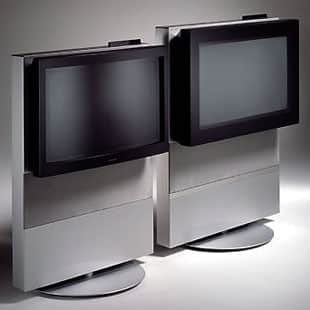
TV isn’t just something you watch, it’s something you experience. That’s why BeoVision Avant makes a big deal about giving you the best in audio-visual entertainment. The BeoVision Avant was created as a video system, but during its design, the idea came up of making the television a picture on the wall. This has been achieved by deceiving the eye: this is a familiar ploy in the very best of designs.
The BeoVision Avant gives you a television that acts like a picture on the wall: a wall you personally position in the room. It has a built-in video which is invisible to the viewer. Everything is operated via the Beo4 remote control. You have full control from the best seat in the living room, and the television turns towards the viewer using the motorised base.
BeoVision Avant – designed by David Lewis – was a totally new concept from Bang & Olufsen and was introduced in 1995. This video system is completely integrated holding a widescreen television, a hi-fi stereo VCR and a couple of active speakers in its attractive-looking cabinet. It was also the first wide-screen TV from Bang & Olufsen ever. Although by the end of the twentieth-century widescreen TVs were taking more and more market share, most TVs still used the 4:3 format. When Bang & Olufsen started planning for this model they originally envisaged to use the same technology then currently used in the MX series but along the way they decided to develop a completely new chassis. This new chassis is much more advanced.
The Avant is also a very environment-friendly TV using a lot of recycled material as well being recyclable itself at the end of its serviceable life. The set can also be expanded with several add-ons. For example: picture-in-picture (PIP), satellite receiver and Dolby Pro-Logic or Dolby Digital decoder. The Avant is the pathway to the future of video systems; a whole new concept of the most advanced video system from Bang & Olufsen to date.
The widescreen format 16:9 picture tube is used for the first time in the BeoVision Avant. This created conflict between designer David Lewis and Bang & Olufsen’s technicians, as the designer could not see the point of it. A new picture tube that could not be filled by the TV picture. Where randomly placed grey stripes on the picture tube were a part of the framing of the picture most of the time. The technicians did not think it could be their fault. Wide format 16:9 was an attempt to consolidate a whole industry around a new market standard. The designer’s talk of trimming and stretching the picture to fill out the frame was, in their eyes, simply distortion. There was no ideal solution to the dilemma.
Together they had to find the solution that would work best in practice. It was not possible to fill the 16:9 format with a 4:3 TV picture. The necessary trimming and stretching annoyed the eye too much. On the other hand, wide format had a lower limit. In the eyes of designer David Lewis, that lower limit lay in the 14:9 format. The technicians struggled to implement the format with as little distortion as possible. They also checked to see whether designer David Lewis would notice the difference if the format was a little bit smaller. Just a few millimetres smaller on the longer element! But David Lewis saw it straight away. There was a distinct limit in the eye’s perception of the transition to wide format, and it lay at 14:9.
Finally, they managed to come up with a method that could handle the problem satisfactorily in practice. A method that has subsequently been further developed to implement the 15:9 format that is close to the aesthetic ideal: the golden rectangle. Programmes recorded and distributed in 16:9 are the ideal way of filling the wide format, but the range is still limited. Bang & Olufsen’s wide-format TV offers a practical solution to filling the screen with ordinary TV and video programmes. It was created by trained eyes.
TOP TIP
Information valid for:
BeoVision Avant 50 HZ MK I MK II
Intermittent jamming of cassettes during eject; VTR fails
Symptom: Intermittent jamming of certain types of cassettes in the tape mechanism during eject.
Cause: An edge of the cassette or a misfitted label, etc. may catch the lower part of the cassette lid and prevent the cassette from being ejected.
Solution: Replace the cassette lid by the new type, which is fitted with two small round knobs on the lower part of the lid.
To avoid colour differences the lid is supplied together with side panels and the small triangle (BeoVision Avant TV, service manual pos. 9016).
This solution is implemented in the production as from Avant serial number 12159658 (week 38 of 1996)
Its standard features were: VisionClear Technology and multi-format picture. It houses a 16:9 widescreen television with automatic picture adaptation, which means that every broadcast, no matter where it originates, is automatically shown with the optimum reproduction, from news reports in standard format, to movies in widescreen.
BeoVision Avant features the same functions as Beosystem AV 9000. When you turn it on, first it turns on its motorised stand toward your favourite watching-place. Then comes the sound, produced by four active loudspeakers hidden directly underneath the widescreen, while behind the black curtain the picture adapts to its format and to the lighting conditions in the room, before the curtains glide aside and reveal a perfect picture.
BeoVision Avant encourages you to lose yourself in a sound and picture experience – and not in the technology. That’s why we hang the 16:9 Real Flat wide-screen on its own smooth wall and conceal everything else behind it – including a set of speakers that will outpace the average hi-fi and a video recorder that tunes itself automatically.
You can choose a built-in DVD player or video tape recorder and from a range of five colours. There’s also the option of a simplified 66cm version with no integrated entertainment source.
Design
Close your eyes and imagine the perfect TV. Open them again and take a look at BeoVision Avant. It’s a widescreen TV that’s easy to understand, effortless to use and always a pleasure to watch.
Though a widescreen TV is never going to be small in size, it doesn’t mean that it has to dominate its surroundings. The Avant has a subtle presence and comes in a range of colours that allow it to compliment any environment in which it’s placed.
At Bang & Olufsen, it is taken for granted that when you watch TV, you want to concentrate on the experience rather than on the technology. That’s why the Real Flat screen is ‘hung’ on its own “wall” with everything else concealed behind.
Widescreen
The picture quality provided by the Avant is as close to the real thing as you can get. Its smooth Real Flat widescreen provides the perfect format for movie watching – and together with the exceptional sound creates a spatial illusion that’s second to none.
Switch on the Avant and it automatically adjusts any broadcast to the optimal widescreen picture – no matter what format it was produced in. News and sports broadcasts are expanded from the traditional 4:3 format into 15:9, while movies shot in widescreen are reproduced in a 16:9 format that’s as close to the original cinema version as you can get. And, if you don’t like the picture as it is, you can easily change to another format with the Beo4 remote control.
BeoVision Avant models:
BeoVision Avant 100Hz MK III (832x)
BeoVision Avant 100Hz MK I MK II (830x)
BeoVision Avant 28 DVD (834X)
BeoVision Avant 32 MK II MK III (842x)
BeoVision Avant 32 DVD (844X)
BeoVision Avant 50Hz MK III MK IV (810x)
BeoVision Avant 50Hz MK I MK II (81xx)
BeoVision Avant CTV (836x)
BeoVision Avant RF 28 (833x)
BeoVision Avant RF 28 CTV (837x)
BeoVision Avant RF 32 (843x)
BeoVision Avant US (8490)
Features
Watching movies should be about simple entertainment, not complicated technology. That’s why the Avant is available with its own built-in DVD player or video recorder. Its presence is only given away by a discreet lid on the front. All cables are hidden in the back of the set.
To ensure even greater viewing comfort, the Avant has its own motorised stand that turns effortlessly through a 70 degree arc. You can program it to turn automatically towards your favourite viewing chair, or use the Beo4 to turn it in the opposite direction. When you switch the Avant off again, it returns silently to its original position in line with your furniture.
A red LED display on top of the cabinet gives you a discreet status of the source you are viewing, without intruding on the picture. It also shows the volume status when you adjust the volume level, and other information related to recording, Dolby Surround and so on. On the back of the display is a hidden push button panel for the most frequently used controls.
The Beo4 remote control is used to access all the various functions of video-playback and recording, menus, tuning, text-television, picture optimisation, sound properties and so on. Beo4 is designed for user-friendly and ergonomical operation with one hand. The buttons in a star-shape for search, ultra-sharp still-picture, super slow-motion, programme shift and fast forward can be controlled by your thumb only, you don’t even have to move your eyes. Beo4 also controls all the latest B&O audio systems as well – it’s the key to complete home entertainment!
A discreet display on the upper right hand corner of the Avant lets you know what source is playing and a small control panel placed behind it offers hands-on control of all basic functions.
This television became the basis for renewed efforts in the US television market which has been overall successful.
Let the show commence!
It has been said that ‘Bang & Olufsen’s products are enchanting’ ! And the magic, the good idea, often comes into being in the course of finding a solution to some practical problem. The practical problem here was that there was a short time lag between pressing the button and a picture appearing on the screen. So you would sit and wait expectantly for a little while. The experience of waiting reminded designer David Lewis of a theatre before the curtain went up! Behind the curtain, preparations are being made for the performance.
The lighting and sound are adjusted and the actors take their places. The curtain only goes up when everything is ready. The first television to have a curtain was the BeoVision AV 9000. The curtain was a thin steel sheet that was slid to one side by a clever mechanism when the stage was set. Bang & Olufsen’s wide-format television, the BeoVision Avant, is equipped with an electronic curtain. From the moment you press the button until the curtain slides away, the technology is busily working unnoticed. No pop from the loudspeakers, no random flash of light from the screen. Only when the sound is ready and the picture is in place can the performance begin.
VCR
Underneath the loudspeakers is the access to the VCR. The Avant incorporates the same video-technology as the V8000 systems, namely a stereo VCR that can play back recordings of all standards. The video machine has, naturally, record indexing and it can show the elapsed or remaining time of any cassette being played. Dolby Surround is an option, and when installed, Avant can take the place of the AV9000 video system. Another option is a PIP-module (Picture-In-Picture).
Sound
The perfect picture deserves a sound to match and that’s exactly what the Avant offers. A pair of specially developed loudspeaker units – capable of outperforming many traditional hi-fi setups – are discreetly placed below the screen and offer an exceptional sound performance that will enhance the best action-movie or concert footage.
The BeoVision Avant features a built-in Dolby® Digital* module that lets you bring the cinema directly into your living room. With a pair of loudspeakers from Bang & Olufsen’s BeoLab range positioned at either side of the TV and two more placed at the rear, you can put yourself in the middle of a surround sound experience that’s second to none.
The sound quality of the active loudspeakers can compete with any modern audio system. When the herd of horses approaches your seat from within the widescreen, you can feel the tremble of the horses’ hooves – so powerful is the bass. And as a video-master in a Beolink system, Avant can distribute sound and vision all over your home – just as it can play the music from your audio system in its speakers.
The Perfect Illusion
Press a key on the Beo4 remote and the electronic curtain glides aside to reveal a perfect picture. A theatrical gimmick or another technological leap forward? Actually, a bit of both! In the short reaction time before the curtain glides aside, a comprehensive circuit adjusts contrast levels, brilliance and colour to the prevailing light conditions in the room, ensuring the optimum picture reproduction every time.
An anti-reflective coating on the picture tube, as well as on the contrast screen is provided to eliminate reflections from windows, carpets and furniture. If you watch television during the day you’ve probably experienced the glare and reflections caused by direct sunshine. To minimise the problem, the Avant’s picture tube and contrast screen have been given a special anti-reflection coating that reduces reflections by up to 99%.
Home Cinema
There was a time when watching a movie on TV was a poor imitation of the real thing. But not anymore! BeoVision Avant brings the movies directly into your living room with a smooth, true-to-life picture and totally convincing sound.
BeoLab 2 completes this ultimate surround setup and – together with the other four active loudspeakers – allows you to make the most out of the advanced sound opportunities offered by the Avant’s built-in Dolby® Digital* module.
Colours
BeoVision Avant comes as one integrated unit. All you have to do is to plug in the mains and the antenna and you’re ready to watch. There are no other visible cords, allowing the Avant to be viewed from all sides – so it does not have to be set up in a corner or next to a wall. It fits nicely into any kind on home, thanks to the range of many available cabinet colours: pearly blue, pearly black, pearly red, pearly green and silver.
When the system is turned off, it turns back to its original position, the sound fades away and the curtains glide in front of the screen. Just like being in your own private small-screen cinema!
Wax & fix
The weight of the Avant’s widescreen picture tube called for new thinking in terms of construction. High density fibre board turned out to be as solid a solution as it is environmentally healthy. To disguise its low tech appearance, it is treated to a high quality two-component lacquer of the same type as is used at the upper end of the car industry. It will not scratch easily, but should this happen, a minor scratch can be polished away using liquid silicone car wax.
*Dolby Digital is a trademark of Dolby Laboratories Licensing Corporation
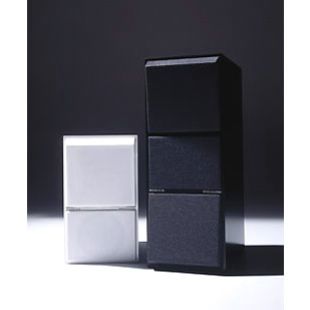
Living proof that big sound need not take up more space than a couple of ring binders, Beovox CX50 snuggled in anywhere, even as extras in a Beolink® system.
Beovox CX50 and Beovox CX100 loudspeakers were the smallest loudspeakers from Bang & Olufsen up to the time that the manufacture of passive speakers ceased in 2002. They were mostly used to place within a passive Beolink® system (MCL), although they could also be used as main speakers. Thanks to different colour combinations they blended well into most people’s décor.
Beovox CX100 finally ceased production in September 2003 – the last of a long and successful line of passive speakers.
Description:
Passive loudspeaker, aluminium cabinet, available in black, white and brushed aluminium.
Replacement drive units: Top drive unit for CX50/CX100 Part number: 411743
Mounting Options
BeoVox CX50/CX100 replaced C40 and was designed to be optionally mounted with the wall brackets supplied in the box.
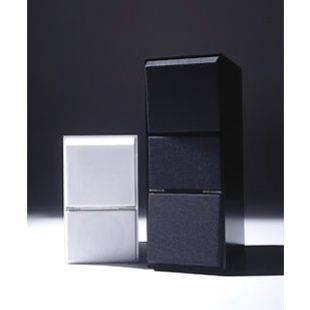
Living proof that big sound need not take up more space than a couple of ring binders, Beovox CX50 snuggled in anywhere, even as extras in a Beolink® system.
Beovox CX50 and Beovox CX100 loudspeakers were the smallest loudspeakers from Bang & Olufsen up to the time that the manufacture of passive speakers ceased in 2002. They were mostly used to place within a passive Beolink® system (MCL), although they could also be used as main speakers. Thanks to different colour combinations they blended well into most people’s décor.
Beovox CX100 finally ceased production in September 2003 – the last of a long and successful line of passive speakers.
Description:
Passive loudspeaker, aluminium cabinet, available in black, white and brushed aluminium.
Replacement drive units: Top drive unit for CX50/CX100 Part number: 411743
Mounting Options
BeoVox CX50/CX100 replaced C40 and was designed to be optionally mounted with the wall brackets supplied in the box.
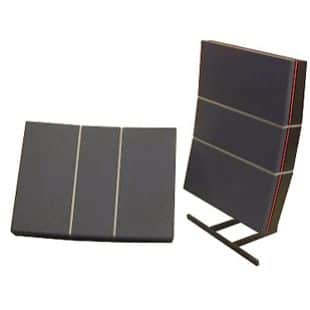
Beovox RL was available in four sizes, each with its own sound experience generated by size and strength.
The speakers accentuated different sound facets when positioned in different ways. Special fittings allowed you to position the three largest RL speakers as you wished. Suspended from the ceiling or on the wall. Standing in a corner or on a shelf. Or placed discreetly on the floor – either on a stand or in direct contact with the floor if you really wanted heavy bass sound – for dancing for example. The hard moulded plastic shell had no parallel surfaces, and the space between the bracing ribs was covered with asphalt. This special construction ensured a pure and authentic sound experience – with minimal cabinet resonance.
The special fittings, available as accessories, made it possible to tilt and turn Beovox RL speakers, in order to focus the sound towards your listening position, giving you the perfect stereo perspective.
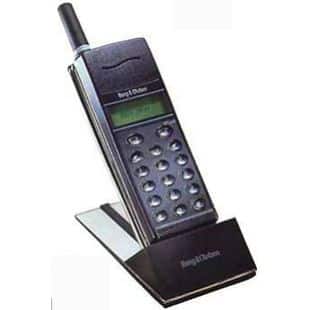
Telephones are for speaking into and for listening to, but why stop at that? When Bang & Olufsen developed their own, they were built on the accumulated knowledge of natural sound, the durability of materials and of logical operation and function.
BeoCom 9600 was a GSM mobile phone in a class of its own as far as materials, manufacture and function were concerned. In spite of its unassuming appearance, it gave the user a loud and clear connection, even in noisy environments and with a card for fax and PC, it gave total mobility.
BeoCom 9600 could be charged with the table-top BeoCharger designed by Henrik Sørig Thomsen, designer of other Bang & Olufsen products such as BeoTalk 1100/1200, BeoCom 6000 and BeoCom 9800.